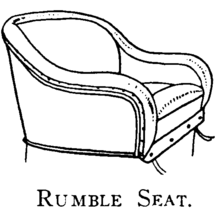Rumble seat
A rumble seat (American English), dicky seat, dickie seat or dickey seat (British English), also called a mother-in-law seat,[1] is an upholstered exterior seat which folded into the rear of a coach, carriage, or early motorcar. Depending on its configuration, it provided exposed seating for one or two passengers.
History
Additional occasional seating appeared in the latter centuries of evolution of the coach and carriage. The 1865 edition of Webster's An American Dictionary of the English Language defines a dickie seat or rumble as "A boot[note 1] with a seat above it for servants, behind a carriage." [2] Similar to the dickie seat on European phaetons was the spider, a small single seat or bench on spindly supports for seating a groom or footman.[3]
Before World War I, dickie or rumble seats did not always fold into the bodywork.[4] Following it, such optional passenger arrangements typically were integrated into the rear deck.[1][5][1] When unoccupied, the remaining space, if any, under the seat's lid could be used for storing luggage.[1]

Roadster, coupe and cabriolet car body styles were offered with either a luggage compartment or a rumble seat in the deck. Models equipped with a rumble seat were often referred to as a sport coupe or sport roadster.
Rumble seat passengers were exposed to the elements, and received little or no protection from the regular passenger compartment top. Folding tops and side curtains for rumble seats were available for some cars[1] (including the two-door version of the Ford Model A) but never achieved much popularity. Among the last American-built cars with a rumble seat were the 1938 Chevrolet,[6] the 1939 Ford[7] and 1939 Dodge[8] and Plymouth.[9] The last British built car with a dickey seat was the Triumph 2000 Roadster made until 1949.[10][11]
See also
Footnotes
- Boot, n. ...3. A box or receptacle covered with leather at either end of a coach. (Webster, Goodrich & Porter 1865, p. 152) The trunk of a car is still known as the "boot" in British English.
Notes
- Haajanen 2003, p. 115.
- Webster, Goodrich & Porter 1865, p. 1156.
- Haajanen 2003, pp. 115, 125.
- Clough 1913, p. 258.
- Georgano 1971, p. 216.
- conceptcarz.com
- Roush Automotive Collection.
- Corporation, Chrysler. "allpar.com". allpar.com. Retrieved 2011-11-20.
- Benjaminson, Jim (1930-04-08). "allpar.com". allpar.com. Retrieved 2011-11-20.
- Lawrence 1997, p. 302.
- Hingston 2007, p. 164.
References
- Benjaminson, Jim. "Early Plymouth convertibles, 1928-1971". allpar.com. Retrieved 2011-11-20.CS1 maint: ref=harv (link)
- Chrysler Corporation, Staff of (1966). "Dodge cars, 1914-1966". allpar.com. Retrieved 2011-11-20.CS1 maint: ref=harv (link)
- Clough, Albert L. (1913). A dictionary of automobile terms. The Horseless Age Company. Retrieved 2014-09-06.CS1 maint: ref=harv (link)
- Georgano, G. N., ed. (1971). "Glossary". Encyclopedia of American Automobiles. New York, NY USA: E. P. Dutton. pp. 215–217. ISBN 0-525-097929. LCCN 79-147885.CS1 maint: ref=harv (link)
- Haajanen, Lennart W. (2003). Illustrated Dictionary of Automobile Body Styles. Illustrations by Bertil Nydén. Jefferson, NC USA: McFarland. ISBN 0-7864-1276-3. LCCN 2002014546.CS1 maint: ref=harv (link)
- Hingston, Peter (2007). The Enthusiasts' Guide to Buying a Classic British Sports Car. Eaton Bishop, Hereford, UK: Hingston Publishing. p. 164. ISBN 978-0-906555-25-5. Retrieved 2014-09-09.CS1 maint: ref=harv (link)
- Lawrence, Mike (1997) [1991]. A to Z of Sports Cars, 1945-1990. Bideford, Devon UK: Bay View Books. ISBN 1-870979-81-8. Retrieved 2014-09-09.CS1 maint: ref=harv (link)
- Roush Automotive Collection, Staff of (16 March 2006). "Spotlight: 1939 Ford Convertible Deluxe". Roush Automotive Collection. Retrieved 2014-09-06.CS1 maint: ref=harv (link)
- Vaughan, Daniel (August 2011). "1938 Chevrolet Master Series HB news, pictures, specifications, and information". conceptcarz.com. Retrieved 2014-09-06.CS1 maint: ref=harv (link)
- Webster, Noah; Goodrich, Chauncey A.; Porter, Noah, eds. (1865). An American Dictionary of the English Language. Springfield, MA USA: G. & C. Merriam https://archive.org/details/americandictiona00websuoft. Retrieved 2014-09-06. Missing or empty
|title=(help)CS1 maint: ref=harv (link)